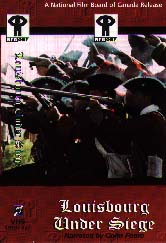


|
Louisbourg Under Siege.
National Film Board, 1997. (in association with the A & E Network)
Subject Headings:
Grades 10 and up / Ages 15 and up.
***1/2 /4
|

This interesting video can be viewed on several levels - a study of two colonial lifestyles for Canadian history, as a study of two North American empires in the context of Western Civilization, and as a military study.
The siege of Louisbourg covers four short decades of history from 1720 to 1760. Viewers see Louisbourg in a whole new context rather than as "just" a fort. To the French, it was a strategic location guarding the entrance to the St. Lawrence and allowing raids on New England. But it also had important economic functions as a transshipment port of goods from the Americas but, even more importantly, for its access to the rich cod fishing grounds.
While Louisbourg was not established for settlement but for commerce and a naval base, the video offers a glimpse into the lifestyle of a colony of France. Here was a society that was structured and bureaucratic and also one riven by class distinctions.
In 1745, Louisbourg became a magnet for the New England colonies which were determined to remove their commercial rival. By launching an amphibious and land siege, the "amateurish" New Englanders surprised the French who had always anticipated a naval assault. The New Englanders dragged cannon through the forests and swamps. (This tactic echoed the efforts of the colonists in their war against Britain during the Revolution and also anticipated the tactics of the Viet Minh in their war against the French in Indochina). A small British naval force blockaded the port and prevented supply to the defenders. In just six weeks, the seemingly impregnable Louisbourg capitulated.
Much to the dismay of the New England colonies, the fort was returned to the French in the peace that ended King George I's War. With the lessons learned from the first siege, General James Wolfe besieged and captured the fort again in 1758. In 1760, Britain decided to destroy the fortifications and deport the inhabitants. In the 1960s, the Canadian government began the fort's restoration with the labor of 800 unemployed miners in the region.
The producers have used breathtaking footage of the reconstructed fort along with an excellent re-creation of the 1745 battle. The Director General of the Canadian War Museum, as well as military historians, provide an understandable commentary throughout the video on the weaponry, strategy, and implications of the military and political decisions made.
This video, a good addition to any Divisional media centre, has elements that can be studied at different levels in different courses, but it may not be wholly suitable for a teacher looking for a "pure" Canadian history play.
Recommended.
Tom Dercola, who has had 29 years experience as a high school teacher, is presently the Humanities Department Head for St. James Collegiate in Winnipeg, MB.


To comment on this title or this review, send mail to cm@umanitoba.ca.
Copyright © 1997 the Manitoba Library Association. Reproduction for personal use is permitted only if this copyright notice is maintained. Any other reproduction is prohibited without permission.
Published by
The Manitoba Library Association
ISSN 1201-9364
TABLE OF CONTENTS FOR THIS ISSUE - NOVEMBER 28, 1997.
AUTHORS | TITLES | MEDIA REVIEWS | BOOKSHELF | BACK ISSUES | SEARCH | CMARCHIVE | HOME